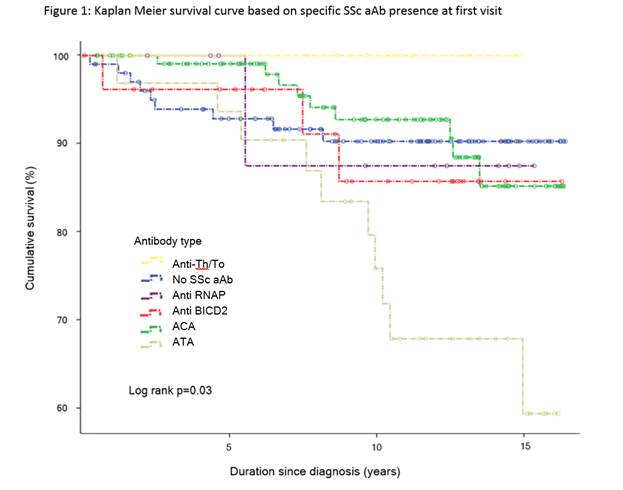Session Information
Date: Sunday, November 5, 2017
Title: Systemic Sclerosis, Fibrosing Syndromes and Raynaud's – Clinical Aspects and Therapeutics Poster I
Session Type: ACR Poster Session A
Session Time: 9:00AM-11:00AM
Background/Purpose:
Systemic sclerosis (SSc) autoantibodies (aAbs) are invaluable for SSc diagnosis and prognosis. Anti-centromere (ACA), anti-topoisomerase I (ATA) and anti-RNA polymerase III (RNAP) have been incorporated into SSc classification criteria, whereas anti-Th/To is much less commonly tested. Meanwhile, newly discovered anti-BICD2 seems particularly interesting in predicting milder SSc.
Our goal was to characterize the aAb profile in French Canadian SSc patients and its correlation with clinical features, nailfold capillaroscopy (NCM) findings and survival rates.
Methods:
Biobanked sera obtained at first visit from 303 SSc patients were tested for SSc aAbs by indirect immunofluorescence, ELISA and immunoblotting. Clinical data and NCM findings at first visit were compared by aAb subsets. Survival status and causes of death were extracted from a previous study (1). Survival was estimated by Kaplan Meier analysis and additional predictors for mortality were identified.
Results:
In the 303 patients, aAb prevalence was: ACA 35% (n=145), ATA 10% (31), anti-Th/To 7% (21), anti-RNAP 4% (12) and anti-BICD2 8.9% (27). All anti-BICD2+ patients were also ACA+ and 96% had limited cutaneous SSc (lcSSc). Only the presence of puffy fingers was more prevalent in anti-BICD2+ patients compared to other ACA+ patients (37% vs 19% respectively, p=0.04). Diffuse cutaneous SSc (dcSSc) was most prevalent in ATA+ (20%) and anti-RNAP+ (68%) patients. Pulmonary fibrosis was more strongly associated with ATA than other aAbs (26% vs 9%, p=0.01). On NCM, anti-RNAP+ patients presented earlier capillary dilations after disease onset than other SSc patients (median interval 0.8 years vs 2 years, p=0.03).
Overall, 32 SSc related deaths occurred after a mean (± SD) of 9.8 (± 4.5) years following diagnosis. Risk factors associated with mortality were dcSSc (OR 2.6, CI 1.3-6.7), lung fibrosis (OR 5.5, CI 2.2-13.6), and anti-SSA/Ro presence (OR 2.5, CI 1.1-5.8). Kaplan Meier analysis of SSc related deaths showed that only ATA+ patients had a significantly lower cumulative 15 year survival rate (58%) (Fig. 1, log rank p=0.03), whereas survival was similar between other aAb subsets, including anti-BICD2.
Conclusion:
These data reaffirm and expand the importance of SSc related aAbs as prognostic markers. ATA are associated with dcSSc, lung fibrosis and worst survival in comparison to other SSc aAbs. Anti-BICD2 was always associated with ACA. The latter were both strongly associated with lcSSc and had similar survival rates. The only difference was an increased prevalence of puffy fingers in anti-BICD2+ patients.
1. Scussel-Lonzetti L, Joyal F, Raynauld JP, Roussin A, Rich E, Goulet JR, et al. Predicting mortality in systemic sclerosis: analysis of a cohort of 309 French Canadian patients with emphasis on features at diagnosis as predictive factors for survival. Medicine (Baltimore) (2002);81:154-167.
To cite this abstract in AMA style:
Zheng B, Mahler M, Senécal JL, Joyal F, Koenig M. Survival and Clinical-Capillaroscopic Characteristics of French Canadian Systemic Sclerosis Patients: Analysis Based on Systemic Sclerosis Autoantibodies and the Novel Anti-BICD2 Autoantibody [abstract]. Arthritis Rheumatol. 2017; 69 (suppl 10). https://acrabstracts.org/abstract/survival-and-clinical-capillaroscopic-characteristics-of-french-canadian-systemic-sclerosis-patients-analysis-based-on-systemic-sclerosis-autoantibodies-and-the-novel-anti-bicd2-autoantibody/. Accessed .« Back to 2017 ACR/ARHP Annual Meeting
ACR Meeting Abstracts - https://acrabstracts.org/abstract/survival-and-clinical-capillaroscopic-characteristics-of-french-canadian-systemic-sclerosis-patients-analysis-based-on-systemic-sclerosis-autoantibodies-and-the-novel-anti-bicd2-autoantibody/

